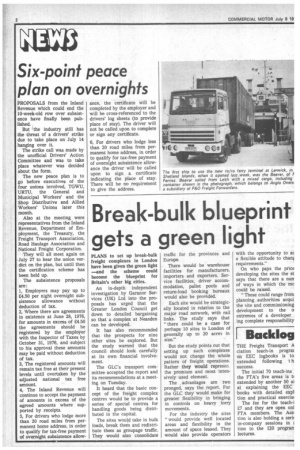Break-bulk blueprint gets a green light
Page 4

If you've noticed an error in this article please click here to report it so we can fix it.
PLANS to set up break-bulk freight complexes in London have been given the green light —and the scheme could become the blueprint for Britain's other big cities.
An in-depth independent investigation by Garanor Services (UK) Ltd into the proposals has urged that the Greater London Council get down to detailed bargaining so that a complex at Neasden can be developed.
It has also recommended that the prospects for nine other sites be explored. But the study warned that the council should look carefully at its own financial involvement.
The GLC's transport committee accepted the report and its recommendations at a meeting on Tuesday.
It heard that the basic concept of the freight complex centres would be to provide a series of special centres for handling goods being distributed in the capital.
The sites would take in bulk loads, break them and redistribute them as groupage traffic. They would also consolidate traffic for the provinces and Europe.
There would be warehouse facilities for manufacturers, importers and exporters. Service facilities, driver accommodation, pallet pools and return-load booking bureaux would also be provided.
Each site would be strategically located in relation to the major road network, with rail links. The study says that "there could be a case for perhaps 10 sites in London of generally up to 20 acres in size."
But the study points out that setting up such complexes would not change the whole pattern of freight operations. Rather they would represen the premium and most intensively used element.
The , advantages are two pronged, says the report. For the GLC they would make for greater flexibility in bringing in controls on heavy lorry movements.
For the industry the sites "would provide well located areas and flexibility in the amount of space leased. They would also provide operators with the opportunity to ac a flexible attitude to chanl requirements."
On who pays the price developing the sites the St says that there are a nun of ways in which the mc could be raised.
"These could range from planning authorities acqui the site and commissioning development to the o extremes of a developer ing complete responsibility




















































































